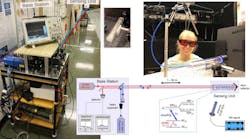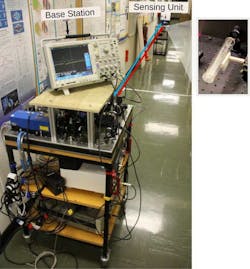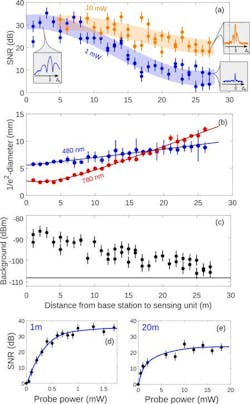Non-Metallic Gigahertz Antenna Built with Laser and Glass Cell
This article appeared in Microwaves & RF and has been published here with permission.
What you’ll learn:
- The underlying quantum-physics principle that was leveraged to create a non-metallic, gigahertz-range antenna.
- How the researchers used lasers and a rubidium cell as the core of the system.
- Details of the entire antenna arrangement and field test results.
Contrary to conventional thinking, a microwave receiving antenna needn’t be metal or even implement a conductor material. Using a rubidium vapor cell with a corner-cube prism reflector to form a passive RF transducer, a team at the respected University of Otago (New Zealand) was able to detect microwave signals at a modest distance from the active components.
Their compact transducer has no electrical components and is optically linked to an active base station by a pair of free-space laser beams that establish an electromagnetically induced transparency scenario.
The Rydberg State
The underlying physics principle they used begins with atoms in a Rydberg state, where one of the electrons in an atom or molecule has been excited to an orbit with a higher principal quantum number.1 Among the interesting properties of these states are extreme sensitivity to external influences such as fields and collisions, extreme reactivity, and very large probabilities for interacting with microwave radiation.
Although the Rydberg state itself has been known since the early days of quantum physics, these sensitivity characteristics were demonstrated in 2012 by a team lead by Jonathan Sedlacek using Rydberg-excited rubidium-87 atoms in a glass vapor cell as a sensitive detector for microwave fields.2
Previous systems for RF measurements and applications were confined to an optical table in a laboratory due to the need to counter-align the two (or more) laser beams within the atomic vapor cell. Other attempts utilized optical fibers bonded to the glass cell to overcome this constraint and separate the laser generation and detection from the RF probe—again, the vapor cell—but that approach also had weaknesses in alignment and losses.
Laser Beams and a Retroreflector
The Otago team replaced the fiber used by previous researchers to access the vapor cell with two free-space laser beams and a corner-cube prism reflector (also called a retroreflector), which reflected the probe beam back to a photodetector (Fig. 1). Their portable atomic-RF probe was able to sense fields at over 30 meters.
The base station contains all of the required elements to prepare two light fields for a two-photon Rydberg system: a coupling and probe laser, their drive electronics, and a setup for the frequency stabilization of the two lasers.
When coupled to a Rydberg state via the optical two-photon transition, the rubidium atoms became sensitive to RF radiation. This happened for RF frequencies that couple the Rydberg level resonantly to other nearby Rydberg levels. For sufficiently large fields, the atoms are receptive to a broad range of RF signals. The lasers detected the changes in energy states in the rubidium atoms.
In their demonstration, a home-built helical antenna broadcast an amplitude-modulated microwave signal with carrier frequencies between 16 and 20 GHz. Their field test (actually, done in their hallway) showed the performance of the fully portable setup (Fig. 2).
They transmitted a 12-dBm/19.84-GHz RF carrier with amplitude modulation at 60 kHz near the sensing unit and extracted the signature of the modulation from the probe beam using a spectrum analyzer (Fig. 3).
Takeaways After Testing
The researchers conclude that the most important characteristic of their portable probe is it contains no electronic circuitry and doesn’t require any metal parts. This reduces scattering of the RF field of interest, which can limit the accuracy of measurements, such as in an anechoic chamber setting.
In comparison to a fiber-coupled approach, their portable probe isn’t bound to any optical fibers and can more easily be transported. However, this comes at the cost of needing some alignment adjustments each time it’s moved.
The work is detailed in their relatively brief but highly readable piece “Distant RF field sensing with a passive Rydberg-atomic transducer,” published in Applied Physics Letters. There’s also a link to Supplementary Material that provides a characterization of the sensing performance of their sensing unit in a parameter space spanned by RF and optical coupling frequencies.
References
1. Texas Tech University, “What's a Rydberg state, anyway?”
2. Nature Physics, “Microwave electrometry with Rydberg atoms in a vapour cell using bright atomic resonances,” September 2012.



